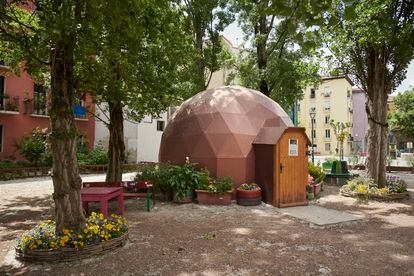How many people enter the Pamplona Town Hall square on July 6, the day the San Fermín chupinazo is launched?
How many meters of unevenness do the bulls climb on the Cuesta de Santo Domingo, the first section of the running of the bulls?
These are two of the questions formulated in the mathematical route that runs through the old quarter of the capital of Navarra and, to discover the answers, they will have to go through it.
This itinerary, designed with a pedagogical focus for sixth grade and second year ESO students, has been developed in a mobile application —MathCityMaps— with the aim that all citizens can enjoy it.
Behind the proposal is the team of Aitzol Lasa, a mathematician, professor and researcher in the Didactics area of the Public University of Navarra (UPNA), who has worked on it together with the Government of Navarra, the Pamplona City Council, the Center for Teacher Training (CAP) and Tornamira, the Association of Mathematics Teachers of Navarra.
The idea arose from a collaboration between entities that were inspired by examples such as Badajoz, where they also have a similar activity to study the historical heritage of the city.
There is a difference.
In other places, the objective is "informative, telling curious things, without fitting into the educational curriculum," Lasa details.
In this case the focus is fundamentally school.
It is about “working maths on the street”, in small groups.
Since the initiative was launched last January until the end of the year, around 870 Primary students will take the route, to which must be added Secondary and tourists.
It is not possible to know with certainty how many people have enjoyed it in total because the application is free and does not count the routes.
There are no accompanying guides to use.
In the case of schools, it is the teachers themselves who attend training and then travel the route together with the students when they consider it appropriate.
In the first edition of the courses at the end of 2021, 28 teachers participated and there was a waiting list.
The University has been in charge of drawing up the itinerary, which consists of six locations of historical or cultural interest in which students are asked to solve various mathematical problems.
The booklets with the complementary information are available on the web and are adjusted to the educational curriculum.
The objective, detailed from the Pamplona town hall, is that students can verify the usefulness of mathematics in everyday life, as well as rediscover the city from different perspectives, interrelating knowledge in the historical-artistic, environmental and even gender fields. .
They are already working on future routes, up to seven, which will run through the various neighborhoods of the Navarran capital.
Different locations of the project to learn mathematics in different environments of Pamplona.PABLO LASAOSA
The particularity of the old town route, explains Lasa, is that "it has a greater point of attraction because there is always an excuse to come".
It is the route that this newspaper travels and that includes several stops.
The first of them, in what is known as the Piparrika orchard.
A community garden that promotes urban ecology and self-managed neighborhood work and where activities are proposed to study triangles, figures that form one of the structures of the place.
From there, travel to the past, to the Roman mosaic of the Museum of Navarra, which allows you to discover geothermal energy and the culture of Pompaelo, the Roman city that constituted what is now Pamplona.
All the stops, emphasizes Aitzol, work on "a specific content of mathematics, be it geometry, measurements, numbers,
statistics or geometric modeling” while linking students with their city, with its history.
In fact, Lasa underlines, the availability of materials, locations and places of interest in the same city is so great that "almost the entire educational curriculum" could be taught with materials that are already available on the streets.
The key is to give meaning to the content.
Among the most popular stops, the
sanfermineras
.
Who has never seen the saint sing before a running of the bulls?
The San Fermín niche is another location, in this case, on the route designed for Secondary school students.
“The question is clear”, Lasa poses, “how big is the slope at the start of the race?
We give some clues.
There is a stone wall and the lines of the blocks are horizontal.
Following the line and measuring it is possible to calculate the slope”.
This type of location is also very popular with tourists.
There is more.
For example, it is common for those who visit for the first time to be surprised by the small size of the town hall where the chupinazo de San Fermín is celebrated.
The actual measurements collide with what is seen on television.
Therein lies the mathematical problem:
How many people can enter the square on July 6?
The students welcome the challenge with enthusiasm: “They don't even need a meter, they are given a one-meter rope, without marking it.
We have seen groups of schoolchildren around a mobile phone entering data.
They fall silent and... 'Good!
We have succeeded!”
Lasa leaves another clue: "Up to 12 people have been placed in a square meter."
There is nothing.
The teacher and tutor of sixth grade at the Cardenal Ilundain center, Juliana Malo, who has also done the route, details that "some with meters, others with steps, it was very interesting to see how they looked for different ways of measuring."
However, there is another location that they liked even more: the Santo Domingo municipal market.
There they carry out a calculation activity, but also management.
“How much does it cost to prepare a menu?
What is a 3x2 offer?
The merchants, acknowledges Malo, “behaved very well”: “They gave one a bit of cheese, another, prawns... it was nice.
It is one of the activities that were done before”.
One of the few drawbacks that Malo puts on the itinerary is the excessive duration of the test.
"Even with four waypoints is enough," she says.
Of course it also depends on the age of the students.
If he had to choose his favorite activity within the route, Lasa would have it clear: calculating the height of public elevators in the city.
Activity in which students are asked to take a photo of themselves next to the structure so that they can deduce the result using the rules of proportionality.
But there is more, many more.
And it is not so much what is included in the itinerary, as everything that has been left out and that is worth visiting.
For example, the spectacular pentagonal structure of the Citadel, built in 1571, considered the best example of military architecture of the Spanish Renaissance and one of the most outstanding defensive complexes in Europe, according to the Pamplona town hall.
Many other locations have been left out, but Lasa encourages those who visit the city to discover it through the application:
Exclusive content for subscribers
read without limits
subscribe
I'm already a subscriber


/cloudfront-eu-central-1.images.arcpublishing.com/prisa/VG2WLXM6FBAEFAGERJTPWY2TQA.jpg)



/cloudfront-eu-central-1.images.arcpublishing.com/prisa/NDOLPLTSMZFBFKHXOW3LXEFPOA.jpg)






